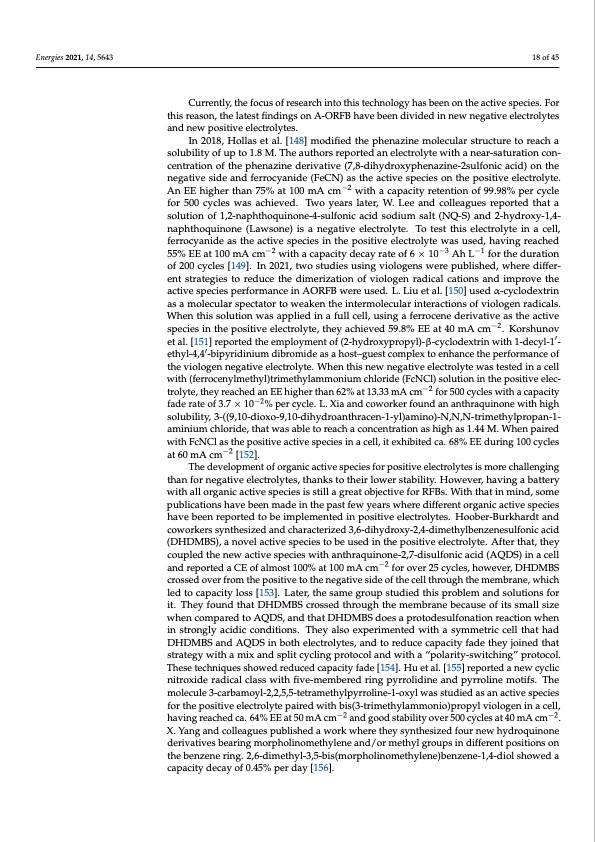
PDF Publication Title:
Text from PDF Page: 018
Energies 2021, 14, 5643 18 of 45 Currently, the focus of research into this technology has been on the active species. For this reason, the latest findings on A-ORFB have been divided in new negative electrolytes and new positive electrolytes. In 2018, Hollas et al. [148] modified the phenazine molecular structure to reach a solubility of up to 1.8 M. The authors reported an electrolyte with a near-saturation con- centration of the phenazine derivative (7,8-dihydroxyphenazine-2sulfonic acid) on the negative side and ferrocyanide (FeCN) as the active species on the positive electrolyte. An EE higher than 75% at 100 mA cm−2 with a capacity retention of 99.98% per cycle for 500 cycles was achieved. Two years later, W. Lee and colleagues reported that a solution of 1,2-naphthoquinone-4-sulfonic acid sodium salt (NQ-S) and 2-hydroxy-1,4- naphthoquinone (Lawsone) is a negative electrolyte. To test this electrolyte in a cell, ferrocyanide as the active species in the positive electrolyte was used, having reached 55% EE at 100 mA cm−2 with a capacity decay rate of 6 × 10−3 Ah L−1 for the duration of 200 cycles [149]. In 2021, two studies using viologens were published, where differ- ent strategies to reduce the dimerization of viologen radical cations and improve the active species performance in AORFB were used. L. Liu et al. [150] used α-cyclodextrin as a molecular spectator to weaken the intermolecular interactions of viologen radicals. When this solution was applied in a full cell, using a ferrocene derivative as the active species in the positive electrolyte, they achieved 59.8% EE at 40 mA cm−2. Korshunov et al. [151] reported the employment of (2-hydroxypropyl)-β-cyclodextrin with 1-decyl-1′- ethyl-4,4′-bipyridinium dibromide as a host–guest complex to enhance the performance of the viologen negative electrolyte. When this new negative electrolyte was tested in a cell with (ferrocenylmethyl)trimethylammonium chloride (FcNCl) solution in the positive elec- trolyte, they reached an EE higher than 62% at 13.33 mA cm−2 for 500 cycles with a capacity fade rate of 3.7 × 10−2% per cycle. L. Xia and coworker found an anthraquinone with high solubility, 3-((9,10-dioxo-9,10-dihydroanthracen-1-yl)amino)-N,N,N-trimethylpropan-1- aminium chloride, that was able to reach a concentration as high as 1.44 M. When paired with FcNCl as the positive active species in a cell, it exhibited ca. 68% EE during 100 cycles at 60 mA cm−2 [152]. The development of organic active species for positive electrolytes is more challenging than for negative electrolytes, thanks to their lower stability. However, having a battery with all organic active species is still a great objective for RFBs. With that in mind, some publications have been made in the past few years where different organic active species have been reported to be implemented in positive electrolytes. Hoober-Burkhardt and coworkers synthesized and characterized 3,6-dihydroxy-2,4-dimethylbenzenesulfonic acid (DHDMBS), a novel active species to be used in the positive electrolyte. After that, they coupled the new active species with anthraquinone-2,7-disulfonic acid (AQDS) in a cell and reported a CE of almost 100% at 100 mA cm−2 for over 25 cycles, however, DHDMBS crossed over from the positive to the negative side of the cell through the membrane, which led to capacity loss [153]. Later, the same group studied this problem and solutions for it. They found that DHDMBS crossed through the membrane because of its small size when compared to AQDS, and that DHDMBS does a protodesulfonation reaction when in strongly acidic conditions. They also experimented with a symmetric cell that had DHDMBS and AQDS in both electrolytes, and to reduce capacity fade they joined that strategy with a mix and split cycling protocol and with a “polarity-switching” protocol. These techniques showed reduced capacity fade [154]. Hu et al. [155] reported a new cyclic nitroxide radical class with five-membered ring pyrrolidine and pyrroline motifs. The molecule 3-carbamoyl-2,2,5,5-tetramethylpyrroline-1-oxyl was studied as an active species for the positive electrolyte paired with bis(3-trimethylammonio)propyl viologen in a cell, having reached ca. 64% EE at 50 mA cm−2 and good stability over 500 cycles at 40 mA cm−2. X. Yang and colleagues published a work where they synthesized four new hydroquinone derivatives bearing morpholinomethylene and/or methyl groups in different positions on the benzene ring. 2,6-dimethyl-3,5-bis(morpholinomethylene)benzene-1,4-diol showed a capacity decay of 0.45% per day [156].PDF Image | PNNL Vanadium Redox Flow Battery Stack

PDF Search Title:
PNNL Vanadium Redox Flow Battery StackOriginal File Name Searched:
energies-14-05643-v2.pdfDIY PDF Search: Google It | Yahoo | Bing
Salgenx Redox Flow Battery Technology: Salt water flow battery technology with low cost and great energy density that can be used for power storage and thermal storage. Let us de-risk your production using our license. Our aqueous flow battery is less cost than Tesla Megapack and available faster. Redox flow battery. No membrane needed like with Vanadium, or Bromine. Salgenx flow battery
| CONTACT TEL: 608-238-6001 Email: greg@salgenx.com | RSS | AMP |